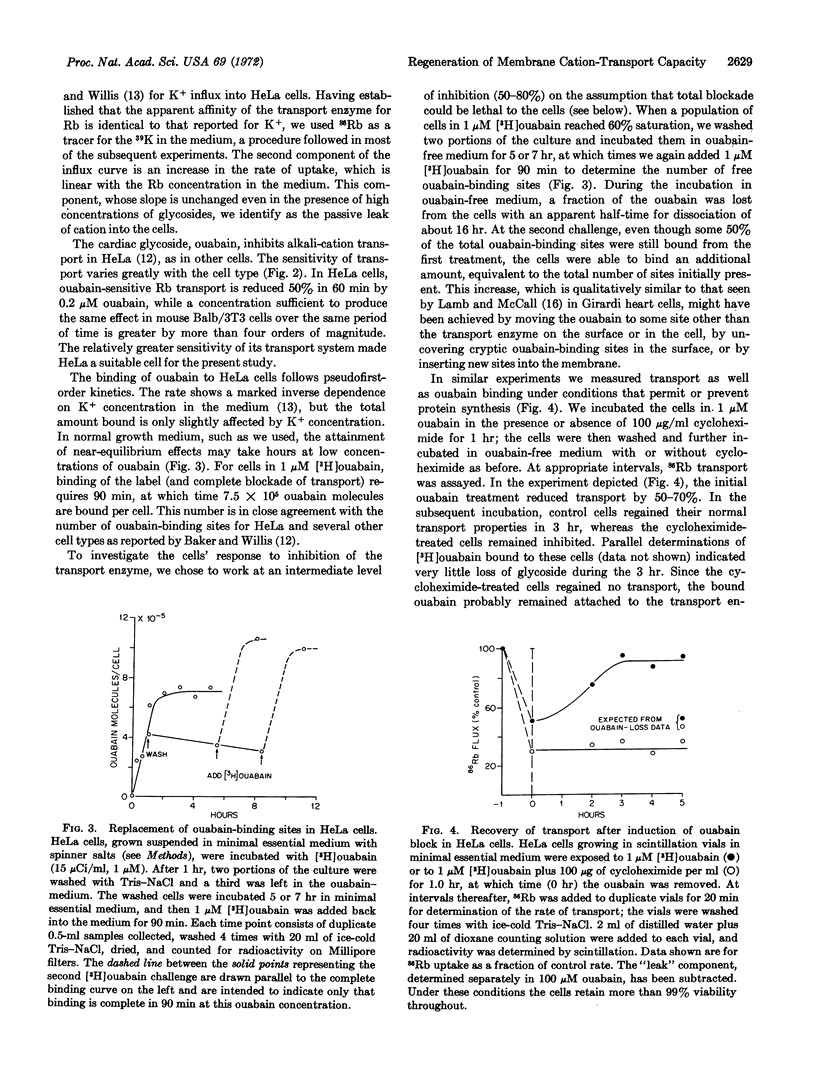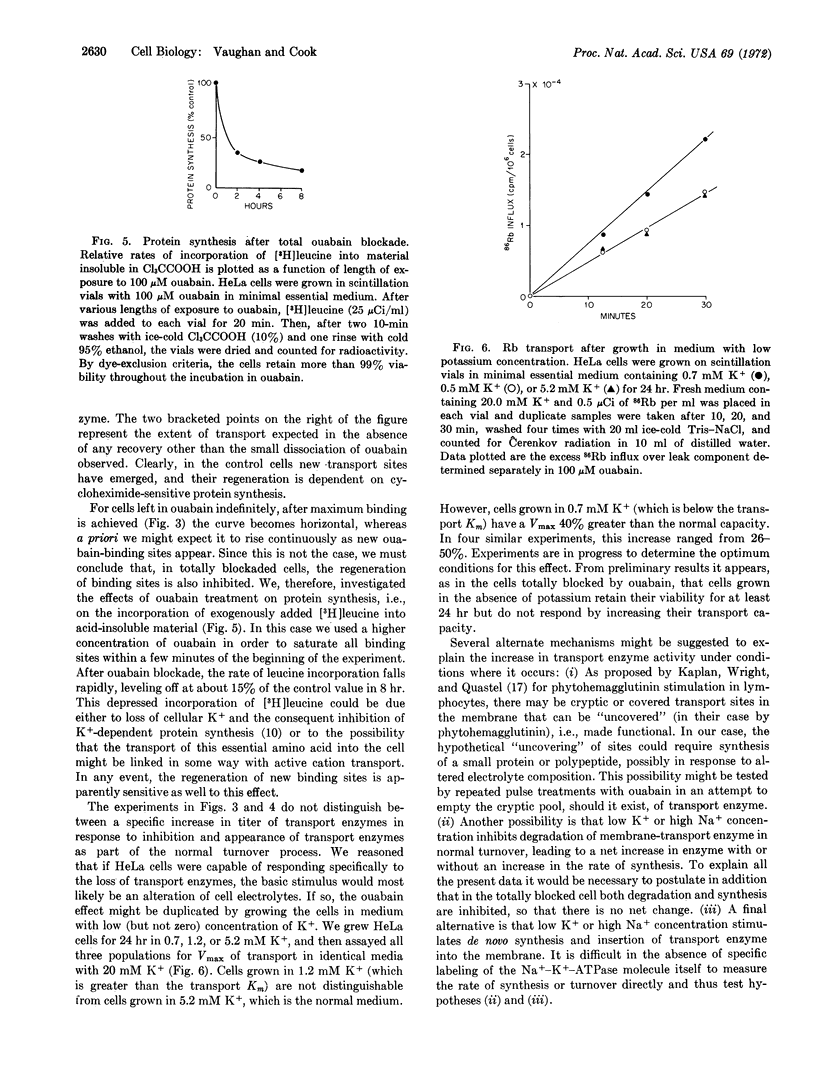Abstract
The cardiac glycoside, ouabain, inhibits alkali-cation transport in HeLa cells. It binds to 0.75 × 106 sites per cell, and the half-time for its dissociation is 16 hr. After partial blockade by ouabain, the cell generates new ouabain-binding sites, with total restoration of transport in 10% of a cell cycle(∼3 hr). This recovery requires protein synthesis and appears to be a response to altered cell-electrolyte content, since growth of cells in media with low K+ concentration enhances the titer of the transport enzyme in a fashion similar to the effect of ouabain. Totally blocked cells do not recover.
Keywords: ion transport, repair, cardiac glycoside, plasma membrane
Full text
PDF




Selected References
These references are in PubMed. This may not be the complete list of references from this article.
- Baker P. F., Willis J. S. On the number of sodium pumping sites in cell membranes. Biochim Biophys Acta. 1969;183(3):646–649. doi: 10.1016/0005-2736(69)90180-1. [DOI] [PubMed] [Google Scholar]
- Baker P. F., Willis J. S. Potassium ions and the binding of cardiac glycosides to mammalian cells. Nature. 1970 May 9;226(5245):521–523. doi: 10.1038/226521a0. [DOI] [PubMed] [Google Scholar]
- GLYNN I. M. THE ACTION OF CARDIAC GLYCOSIDES ON ION MOVEMENTS. Pharmacol Rev. 1964 Dec;16:381–407. [PubMed] [Google Scholar]
- Hughes R. C., Sanford B., Jeanloz R. W. Regeneration of the surface glycoproteins of a transplantable mouse tumor cell after treatment with neuraminidase. Proc Natl Acad Sci U S A. 1972 Apr;69(4):942–945. doi: 10.1073/pnas.69.4.942. [DOI] [PMC free article] [PubMed] [Google Scholar]
- Jung C., Rothstein A. Cation metabolism in relation to cell size in synchronously grown tissue culture cell. J Gen Physiol. 1967 Mar;50(4):917–932. doi: 10.1085/jgp.50.4.917. [DOI] [PMC free article] [PubMed] [Google Scholar]
- Lamb J. F., McCall D. Uptake of (3H)ouabain and Na pump turnover rates in monolayer cultures of Girardi heart cells. J Physiol. 1971 Mar;213(2):57P–58P. [PubMed] [Google Scholar]
- Levine H., Trindle M. R., Moldave K. Monovalent cation requirement for the aminoacyl transfer reaction in protein synthesis. Nature. 1966 Sep 17;211(5055):1302–1303. doi: 10.1038/2111302a0. [DOI] [PubMed] [Google Scholar]
- Philipson L., Lonberg-Holm K., Pettersson U. Virus-receptor interaction in an adenovirus system. J Virol. 1968 Oct;2(10):1064–1075. doi: 10.1128/jvi.2.10.1064-1075.1968. [DOI] [PMC free article] [PubMed] [Google Scholar]
- Rink H., Bergeder H. D. Uber den Einfluss strahleninduzierter Elektrolytverschiebungen auf den Stoffwechsel. I. Untersuhungen am Enyzm Koazetokinase in Hefe. Strahlentherapie. 1968 Mar;135(3):354–363. [PubMed] [Google Scholar]
- SHAW T. I. Potassium movements in washed erythrocytes. J Physiol. 1955 Sep 28;129(3):464–475. doi: 10.1113/jphysiol.1955.sp005371. [DOI] [PMC free article] [PubMed] [Google Scholar]
- Schwartz B. D., Nathenson S. G. Regeneration of transplantation antigens on mouse cells. Transplant Proc. 1971 Mar;3(1):180–182. [PubMed] [Google Scholar]
- Warren L., Glick M. C. Membranes of animal cells. II. The metabolism and turnover of the surface membrane. J Cell Biol. 1968 Jun;37(3):729–746. doi: 10.1083/jcb.37.3.729. [DOI] [PMC free article] [PubMed] [Google Scholar]
- Werb Z., Cohn Z. A. Cholesterol metabolism in the macrophage. II. Alteration of subcellular exchangeable cholesterol compartments and exchange in other cell types. J Exp Med. 1971 Dec 1;134(6):1570–1590. doi: 10.1084/jem.134.6.1570. [DOI] [PMC free article] [PubMed] [Google Scholar]


